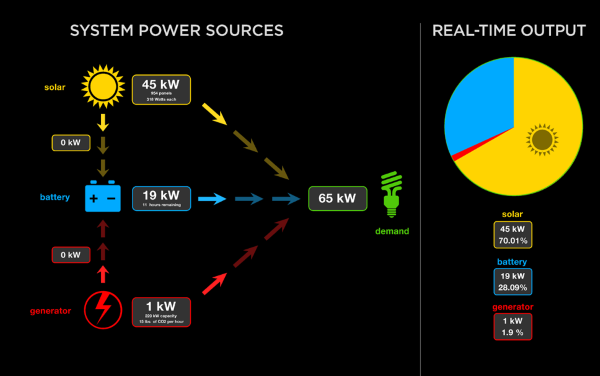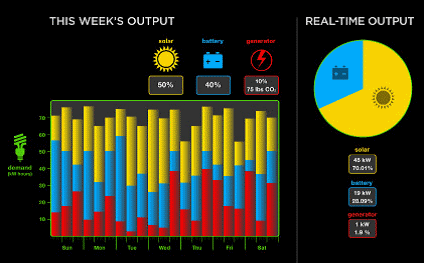BY DARREN HAMMELL,
Co-founder, Chief Strategic Officer,
Princeton Power Systems,
www.princetonpower.com
Recent events like Hurricane Sandy and others have shown that the electrical grid is not resilient under all circumstances and that electrical power distribution can fail for larger periods of time. It is therefore of vital importance to provide solutions for emergency power generation and power distribution to at least sections of the electrical grid (“microgrids”) to allow communities to provide critical services of different types such as health services (hospitals, shelters), energy supply (gas stations), or safety (police, firefighters). Planning and implementing a microgrid poses challenges for a community to identify which services are critical, identify how much distributed power generation is necessary to support the microgrid and then to implement it by installing the required technical infrastructure. Back-up diesel fuel can be helpful for a limited duration, but in long-term events, such as post-Katrina or Sandy, liquid fuels are likely to be unavailable. The military and DoD has become increasingly aware of this situation, which is why it’s working to reduce its dependence upon fossil fuels and has aggressive plans to incorporate new technologies and capabilities in smart and microgrids and in alternative/renewable technologies. Navigant Research recently sited, “Microgrids can shrink the amount of fossil fuels consumed to create electricity by networking generators as a system to maximize efficiency.”
Energy storage allows consumers and businesses to reduce their reliance on the grid, and can be implemented in a number of ways. A good example of a microgrid is one of the U.S. National Park Service – they were looking for an alternative way of powering Alcatraz Island in order to reduce fuel costs and pollution. Princeton Power Systems completed a Commercial scale Microgrid System on Alcatraz Island as a solution to high diesel fuel costs, pollution in the bay area, and high carbon emissions. When a ship’s anchor ruptured the underwater power lines in 1950, that linked the island to San Francisco, Alcatraz was forced to turn to diesel fuel and coal as its source of power.
The solution
A microgrid system, comprised of inverters, a solar array, advanced lead-acid batteries, a site controller, and back-up generators, was selected to independently power the island. This article discusses the deployment and operation of this microgrid, in which preserving the island in pristine condition during the installation was a challenge. Given the system size, it required a large construction effort, and component placement was key.
Microgrid design
This project reflects the National Park Service’s initiative to find an alternative way of powering the island in order to reduce fuel costs and pollution. A microgrid system, comprised of PPS inverters, a solar array, advanced batteries, a Princeton Power Systems Site Controller, and back-up generators, was selected as a way to independently power the island. Designing and building the system on one of California’s, and the U.S.’s, most well-known historic landmarks with over 1 million visitors per year created many challenges.
Component placement
Preserving the island in pristine condition while completing the installation was the greatest challenge. Given that a system of this size requires a large construction effort, component placement was key. To prevent the solar array from being visible from San Francisco, it was placed on the roof of the prison in a flat configuration rather than a traditional angled configuration. The inverters, battery rack, and generators were placed in the old generator room, as this space is isolated and not accessible for tourists. The room was also protected from the harsh salt water environment.
Commissioning
The fragile natural environment and wildlife, particularly the birds (Alcatraz is an old Spanish word for pelican), added to the challenge. Extra attention was given to the solar panels after being damaged by rocks and shells dropped from overhead birds. Despite the coarse condition of the generator room, engineers were able to insulate the room to prevent future problems and ensure reliable long-term operation.
Figures 1a/b is based on a pre-commissioning test conducted the month before the system became fully operational. The total island load varies typically between 50 and 80 kW. The PV array produces a peak power each day of roughly 175 kW. The next sum of these two is supplied by the PPS ESS system at all times. The batteries absorb all of the excess PV when PV exceeds the load requirement, and they deliver whatever load the PV does not cover at all other times. In this figure, for illustrative purposes, the backup generator was turned on, allowing the ESS to charge all of the batteries to 100% state of charge.


Figs. 1a and 1b: Alcatraz island info kiosk provides real-time information on the microgrid showing how much of the island’s power is produced by solar, battery, and generator.
The chart shows the batteries’ power absorption diminishing to zero as the batteries become fully charged. The excess PV power in this case was fed back into the generator, as you can see the generator power be¬comes negative. When the generator is shut down, since the batteries are fully charged, there is no room to absorb PV power that exceeds the load; therefore the system automatically limits the PV production at the time to be equal only to what the load and the batteries can absorb.
This is managed using a frequency-shifting control strategy that requires zero communications among the microgrid inverters. Once the PV production is less than the island loads, the batteries again resume supply¬ing the balance of required power.
Benefits
Energy resilience to protect key critical infrastructure and public resources for a community that will translate to other communities in the United States. The implementation of this proposed solution will improve upon outage time of critical loads, reduce emissions, and improve system energy efficiencies of the selected microgrid.
About Princeton Power Systems
Princeton Power Systems designs and manufactures state-of-the-art technology solutions for energy management, microgrid operations and electric vehicle charging. We are a global leader working with customers and partners across North America, Europe, Africa and the Caribbean. Our UL and CE-certified power electronics are used in advanced battery operations and alternative energy, with built-in smart functions for ancillary services. We also build customized, integrated systems and design, commission and operate microgrids. Based in New Jersey, we proudly manufacture our products in the USA.
Advertisement





